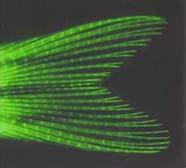
Classification
Scientific name:
Margariscus margarita
The name "pearl" refers to a pearl made within some mollusks
that is considered a gem, derived from the Latin word 'perna'
which refers to a sea mussel. The word "dace" is from the Latin
word 'darsus' and is used to refer to American cyprinid
freshwater fish (Merriam-Webster, 2013).
Margarita: Latin for "pearl"(Online Etymology Dictionary, 2013)
Classification:
Kingdom: Animalia
Phylum: Chordata
Class: Actinopterygii
Order: Cypriniformes
Family: Cyprinidae
Genus: Margariscus
Species: Margariscus margarita
Classification information obtained from Encyclopedia of life (2013)
Domain: Eukarya
Eukaryotes are one of the three domains, including Archaea and Eubacteria. Eukaryotes are more complex than the later two, having a cytoskeleton and organelles (Encyclopedia of life, 2013).
Kingdom: Animalia
Animalia include multicellular, non-plant and non-fungi organisms. This group of species is diverse, yet share common characteristics such as being heterotrophic (Encyclopedia of life, 2013).
Phylum: Chordata
Chordates are animals that possess qualities such as a nerve cord and notochord, most having bilateral symmetry as well (Encyclopedia of life, 2013).

Class: Actinopterygii
This class of organisms consist of ray-finned fishes. Different from lobe-finned fish, their fins are upheld by bony spines, or rays as pictured to the right (Encyclopedia of life, 2013).
Order: Cypriniformes
This order of species posesses a structure called the Weberian apparatus that links the auditory system to the gas bladder. Instead of having teeth on the jaws, they have teeth located in the throat. Also, on their back is a single dorsal fin, lacking an adipose fin (Cypriniformes Commons, 2010).
Family: Cyprinidae
The family Cyprinidae is very diverse, being the most species-rich fish family. This makes its hard to define this group. However, members of this family have a dorsal fin (as listed above), cyloid scales, abdominal pelvic fins, and they generally have a lateral line (Rohde, 2009). Along with the characteristics listed for the order Crypiniformes, Cyprinidae also lay eggs and usually have no scales on their head (Encyclopedia of life, 2013).
Genus: Margariscus
Currently, there are only two species in the family Cyprinidae with the genus of Margariscus. These species are Margariscus margarita and Margariscus nachtriebi, differing in the number of lateral line scales(Cunningham, 2006) .
Species: Margariscus margarita
The two species of Margariscus differ in lateral line scale number. M. margarita has 46-60 scales along it's lateral line, which is usually complete (Stauffer, 2001), while M. nachtriebi has anywhere from 62-17 scales (Cunningham, 2006). It can be easy to confuse M. margarita with some other species, but can be identified by a bottom jaw that does not surpass the length of it's upper jaw. The pearl dace also has a long body with a short snout and a small mouth. Sometimes, there is a barbel in one or both of the corners of the mouth as well. The coloration of M. margarita is grey towards the dorsal region and silver/white towards the ventral region, with males expressing a lateral red stripe along the body. This stripe can vary in brightness, being most prominent during mating season (Stauffer, 2001).
Where does Margariscus margarita live?